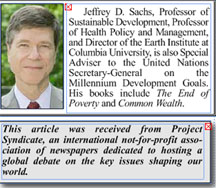By Jeffrey Sachs
NEW YORK – Fifty years ago, President John F. Kennedy did the seemingly impossible. At the height of the Cold War, he moved the two nuclear superpowers, the United States and the Soviet Union, toward peace. The lessons of Kennedy’s act of leadership – one of the greatest of modern times – are directly relevant today. I recount this remarkable story in a new book, To Move the World. To many, war between the two superpowers seemed inevitable. The Cuban missile crisis in October 1962 created a global air of fear and pessimism, and certainly the belief that the US and the Soviet Union could not be reconciled.
Kennedy knew better. He understood that much of the dangerous tension stemmed from each side’s hardliners, who acted as if peace were impossible. Their actions on one side would provoke the other side’s hardline response, fueling an upward spiral of distrust that strengthened the extremes in both camps.
The “experts” of that era spoke of the balance of nuclear power. They believed that neither side would use nuclear weapons, owing to the fear of retaliation. But Kennedy recognised something far more dangerous: Accidents, misjudgments, bluffs, provocation by hardliners, or

